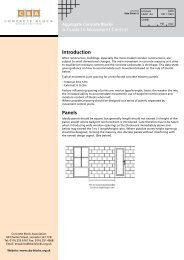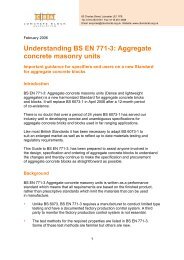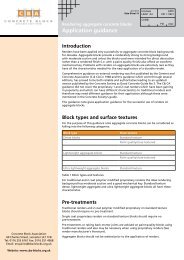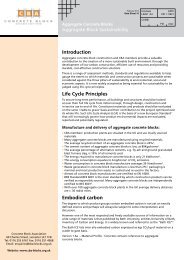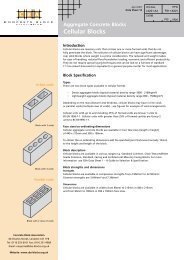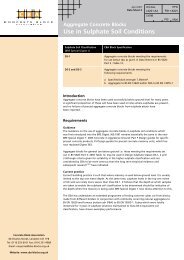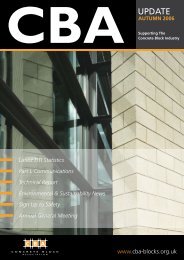Latest CBA Newsletter - Concrete Block Association
Latest CBA Newsletter - Concrete Block Association
Latest CBA Newsletter - Concrete Block Association
Create successful ePaper yourself
Turn your PDF publications into a flip-book with our unique Google optimized e-Paper software.
TECHNICAL REPORT<br />
10. The performance of the product identified in 1 and 2 is<br />
in conformity with the declared performance in 9.<br />
This declaration of performance is issued under the<br />
sole responsibility of the manufacturer identified in 4.<br />
Signed on behalf of the manufacturer:<br />
Quality manager<br />
(name and function)<br />
<strong>Concrete</strong>town, 30.06.2013<br />
(Place and date of issue)<br />
........... (Signature)<br />
Notes<br />
Configuration You have the choice of<br />
giving details of the volume of voids, shell<br />
and web thicknesses as specified in BS EN<br />
771-3 or just stating the Group of unit.<br />
Group 1 units are those with up to and<br />
including 25% voids.<br />
Group 2 units are those with more than<br />
25% voids.<br />
Units cast on end and also containing<br />
voids (ie horizontally perforated) will be<br />
group 4 units. (Perforations I group 1 & 2<br />
units are vertical).<br />
It is recommended that you give NPD<br />
against the ‘shape and features’ box and<br />
state the group.<br />
Compressive strength/ unit category You<br />
have to state category I or Category II.<br />
Category I applies if you have third party<br />
surveillance of your factory production<br />
control.<br />
Dimensional stability This is moisture<br />
movement and you should have had<br />
this property measured for each product<br />
(ie each strength of each product) you<br />
manufacture. However, do not give the<br />
measured value but one you are confident<br />
of achieving.<br />
Bond strength The shear bond strength is<br />
a tabulated value so give the value shown<br />
in the example.<br />
Flexural bond strength is only required in<br />
Finland so put NPD.<br />
Reaction to fire Complete as indicated<br />
unless your product contains more than<br />
1% combustible material by mass or<br />
volume.<br />
Water absorption You only need to give a<br />
value if your product is for use externally<br />
without render (normally a facing unit).<br />
Again if you need to measure it is best<br />
to give a safe value rather than the<br />
measurement result.<br />
Water vapour permeability This is used<br />
in condensation risk calculations and the<br />
tabulated value given can be used unless<br />
you make dense aggregate blocks with<br />
a gross density of 2200kg/m 3 when you<br />
should give a value of 30/100 or 50/150<br />
for a density of 2300kg/m 3 or greater<br />
Thermal resistance BS EN 771-3 allows you<br />
to give the λ 10,dry<br />
, unit value or density and<br />
configuration. Tables of λ 10,dry<br />
, unit values<br />
are given below. These are values which<br />
have not been corrected for equilibrium<br />
moisture content so are only to meet the<br />
legal requirements of giving a value in<br />
the DoP. For trade within Europe where<br />
products cross borders and countries have<br />
different assumed equilibrium moisture<br />
contents for masonry units it is convenient<br />
way of supplying a value. For units with<br />
voids an equivalent or apparent λ-value<br />
would need to be given. This will need<br />
to be calculated in accordance with BS<br />
EN ISO 6946. The λ 10,dry<br />
value is not to be<br />
confused with a design value. For voided<br />
units the choice of providing density and<br />
configuration details may therefore be<br />
more convenient.<br />
Durability against freeze/thaw The UK<br />
guidance on this used to be in BS 5628-3<br />
but is now in PD 6697.<br />
You will need to state ‘not to be used<br />
exposed’ for units which are not one of<br />
the following:<br />
Dense blocks or Lightweight aggregate<br />
blocks of at least 1500kg/m 3 density or<br />
Lightweight aggregate blocks of at least<br />
7.3N/mm 2 strength.<br />
Otherwise state ‘pass’.<br />
Dangerous substances State NPD as there<br />
is no requirement to address this property<br />
in the masonry standards as yet.<br />
The following λ10,dry, unit values should<br />
be used for solid units (interpolate for<br />
intermediate densities).<br />
Density<br />
λ 10,dry,unit<br />
1800 0.82<br />
1900 0.90<br />
2000 1.00<br />
2100 1.11<br />
2200 1.24<br />
2300 1.37<br />
Values for dense and manufactured<br />
stone units<br />
Density<br />
800 0.19<br />
900 0.22<br />
1000 0.26<br />
1100 0.30<br />
1200 0.34<br />
Values for pumice units<br />
λ 10,dry,unit<br />
Density<br />
λ 10,dry,unit<br />
600 0.16<br />
700 0.19<br />
800 0.22<br />
900 0.26<br />
1000 0.30<br />
1100 0.34<br />
1200 0.39<br />
Values for expanded clay units<br />
Density<br />
The simplest form of CE marking given as<br />
an example in the draft amendment to<br />
Annex ZA of EN 771-3 is:<br />
AnyCo SA<br />
Any Street 1<br />
B-1050 BRUSSELS<br />
Where:<br />
13<br />
λ 10,dry,unit<br />
1200 0.33<br />
1300 0.35<br />
1400 0.37<br />
1500 0.39<br />
Values for FBA units<br />
Density<br />
λ 10,dry,unit<br />
1200 0.52<br />
1300 0.58<br />
1400 0.66<br />
1500 0.74<br />
1600 0.83<br />
Values for other lightweight aggregates<br />
(eg blends)<br />
(your product code)<br />
EN 771-3<br />
DoP: (your product code)<br />
NB: None<br />
Product information: www.anyco.be/(your product code)<br />
The number 13 is the year in which the<br />
CE mark was first affixed<br />
NB refers to the Notified Body (the<br />
body responsible for the surveillance of<br />
your FPC – if any)<br />
The final line is the link to your DoP for<br />
the product<br />
Unless there is agreement with UK<br />
Trading Standards to supply the CE<br />
mark electronically this is the minimum<br />
information you will be able to supply with<br />
every delivery/collection.<br />
The requirements are that the CE mark is<br />
given on the product or on the packaging<br />
or on/with delivery documentation. This<br />
will mean that it is supplied on/with<br />
delivery documentation by most members.<br />
As merchants will need to pass on your CE<br />
mark when they sell from yard stock it will<br />
be advantageous to keep CE marking as<br />
simple as possible. Having a link to your<br />
website and the DoP, which the merchant<br />
can quote on his delivery documentation,<br />
will probably be the best option to achieve<br />
simplicity.<br />
Continued<br />
www.cba-blocks.org.uk 11




